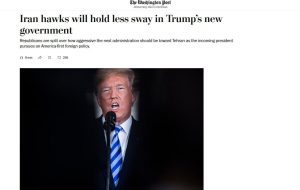Cycles of conflict – Tehran Times
TEHRAN – Abigail Hauslohner’s article, “Iran hawks will hold less sway in Trump’s new government,” published in the Washington Post on November 17, delves into the escalating rhetoric from U.S. Republican leaders advocating for a hardline approach toward Iran. While the piece effectively highlights the resurgence of hawkish policies under President-elect Donald Trump, it falls


TEHRAN – Abigail Hauslohner’s article, “Iran hawks will hold less sway in Trump’s new government,” published in the Washington Post on November 17, delves into the escalating rhetoric from U.S. Republican leaders advocating for a hardline approach toward Iran.
While the piece effectively highlights the resurgence of hawkish policies under President-elect Donald Trump, it falls short in contextualizing Iran’s actions and policies within the broader historical and geopolitical landscape.
A comprehensive understanding of these developments requires an exploration of Iran’s perspective on issues like military threats, sanctions, and U.S. foreign policy.
Hauslohner reports on calls by U.S. lawmakers to target Iran’s nuclear facilities and oil infrastructure as part of a renewed “maximum pressure” strategy. These proposals, however, disregard Iran’s legitimate right to self-defense and sovereignty.
Tehran’s missile launches, discussed in the article, are not acts of aggression but proportionate responses to decades of threats and provocations from Israel and its allies. Such measures are seen as necessary safeguards to ensure national security amid persistent external pressures.
The article also highlights a possibility of revival of strict sanctions and punitive measures but overlooks their ineffectiveness in achieving U.S. objectives.
It is apparent that the “maximum pressure” campaign of Trump’s first term—including sanctions, military threats, and the assassination of General Qassem Soleimani—has failed to weaken Iran’s regional influence or lead to diplomatic breakthroughs.
Instead, it reinforced national unity and deepened mistrust of U.S. intentions. Moreover, sanctions have disproportionately harmed ordinary Iranian citizens, further fueling resentment toward American policies.
While U.S. sanctions are officially aimed at Iran’s government, their harshest effects are felt by ordinary citizens. Restrictive measures have crippled Iran’s economy, causing skyrocketing inflation and shortages of essential goods, including life-saving medications.
Although Hauslohner touches on potential diplomatic overtures, such as a reported meeting between Elon Musk and Iran’s UN ambassador, her focus remains on military posturing.
Tehran has consistently advocated for dialogue as a means to resolve disputes, even during periods of heightened tension. However, past opportunities for negotiation have been undermined by hawkish figures like John Bolton and Mike Pompeo, eroding Tehran’s trust in the U.S. as a reliable partner for meaningful diplomacy.
The article portrays Iran as a destabilizing force in West Asia, a characterization that Tehran firmly rejects.
From Iran’s perspective, U.S. actions—including unwavering support for Israel and military interventions in Iraq, Afghanistan, and beyond—are the primary sources of regional instability.
Just in the previous year, Israel received $17.9 billion in U.S. security aid according to a Brown University study. This aid has persisted despite allegations from United Nations experts that Israel’s actions in Gaza are part of a broader genocide, as well as reports of widespread destruction in Lebanon, abuse of Palestinian detainees, and the ongoing blockade of Gaza.
Iran’s policies, whether supporting the Axis of Resistance or bolstering defensive capabilities, are now considered necessary responses to external aggression from Israel. These efforts aim to counter foreign domination and maintain a balance of power in the region.
Hauslohner effectively illustrates how domestic U.S. politics shape foreign policy, noting that much of the hostility toward Iran is driven by partisan agendas.
Tehran recognizes this performative antagonism as a tool for rallying domestic political support rather than addressing genuine regional concerns. Such hostility exacerbates tensions and undermines opportunities for constructive engagement.
The article underestimates Iran’s historical resilience in the face of external pressure. Decades of sanctions, isolation, and military threats have only strengthened national solidarity and resistance to foreign interference. Calls for regime change, as mentioned in Hauslohner’s piece, further solidify Iran’s commitment to defending its sovereignty and self-determination.
Rather than perpetuating a cycle of aggression, the U.S. and its allies should pursue mutual respect and dialogue.
Iran has repeatedly proposed regional security frameworks emphasizing cooperation among West Asian nations, free from foreign interference.
While Hauslohner briefly acknowledges the possibility of diplomacy, she fails to fully explore its potential to replace militarism as a foundation for stability.
Ultimately, Hauslohner’s analysis of the hawkish shift in U.S. foreign policy under President-elect Trump is thorough but incomplete.
It overlooks the broader implications of these policies for Iran and the region. Tehran remains resolute in its defense of sovereignty and its advocacy for diplomacy over conflict.
Decades of experience demonstrate that military threats and sanctions are both ineffective and counterproductive. Stability in West Asia can only be achieved through mutual respect, dialogue, and equitable engagement—principles Iran has consistently championed. Lasting peace demands an end to coercion and a commitment to understanding and cooperation.
